Alternative Chisinau – Soviet architecture in the Moldovan capital
Chisinau, the capital and largest city of the Republic of Moldova, will not win any prizes for architectural attractiveness, but this is hardly surprising given the city’s recent history. A huge earthquake, measuring 7.3 on the Richter scale, devastated the city in November 1940. What was then left was further brought to the brink of annihilation by the onslaught of World War II. German air bombardment and ground assaults by Axis forces, including the Romanians, ensured very little was left of Chisinau by the time the Red Army entered and took the city in August 1944.
Step in the Soviets, who assigned Alexey Shchusev, a native of Chisinau, to formulate a plan and oversee the gradual reconstruction of the city. Shchusev was an acclaimed Russian architect, whose work included Lenin’s Mausoleum and the Kazansky railway terminal in Moscow, and the Marx-Engels-Lenin Institute in Tbilisi (now the Biltmore Hotel). He was also responsible for the rebuilding of Novgorod, one of Russia’s most historically important cities, after its total destruction by the Nazis during World War II. Not surprisingly, Stalinist Empire style heavily influenced Shchusev’s architectural approach and between 1947 and 1949 he laid out plans and began to implement the reconstruction of the city formerly known as Kishinev (Russian name).

During the 1950s, the city’s population expanded and in addition to building grand constructions in keeping with the era, the authorities also erected large-scale, high-rise housing estates to accommodate the influx of people. These huge buildings changed the visible landscape of the city, a legacy that has remained to this day. Soviet redevelopment of Chisinau continued right up until 1991, the year Moldova obtained its independence, with the early 1970s and beyond being the heaviest years of the city’s urban reconstruction.



Truth be told, there isn’t a great deal of conventional sightseeing attractions in the Moldovan capital. The Orthodox Cathedral and the Arc de Triomphe (Holy Gates) are attractive enough, while the city’s main park (Stefan cel Mare Central Park) is good for strolling and a bit of people-watching, but it’s the aftermath of decades of Soviet-influenced construction that is the most compelling reason to visit Chisinau, in our opinion. There are currently plenty of new developments in the city and many of the Communist-era buildings are either in a state of disrepair, abandoned or waiting to be demolished but, for the time being, Soviet-era architecture is still a sizeable feature of Chisinau’s urban appearance and a must-see for anyone with an interest in that particular style and period in history.
There is now a Tourist Information Centre in Chisinau (there wasn’t on our last visit in 2016) and, although we personally didn’t test their knowledge, I’m sure they would be able to help with local transport options if necessary. Much easier, however, is to have data on your phone and use the excellent public transport App called Eway. It tells you where the nearest bus stop is and what bus to get on in order to reach your desired location. How we ever lived without this brilliant invention is beyond me!
Chisinau has an extensive bus network and, at only 2 leu (€0.10) per ticket, riding it is ridiculously cheap. There is no need to buy a ticket in advance as there is always a conductor on the bus. Just make sure you have a fistful of 1 leu notes if you are going to use the system regularly because handing over anything much bigger is likely to piss off the (often) rather frightening-looking female conductors!
Soviet-era architecture, monuments, mosaics and memorials in Chisinau
I’m going to start with places of interest that are walkable/in the centre of the city and later list the locations that are best reached by public transport.
Soviet-era walking tour map (approximately 6 hours)
Soviet-era walking tour of Chisinau (approximately 6 hours)
A good place to begin a Soviet-era walking tour of Chisinau is outside Government House, the giant hulk of a building opposite the Arc de Triomphe. From this point, continue along Stefan cel Mare Boulevard, Chisinau’s main drag, in a northwest direction until you reach the Moldova National Opera Ballet. It’s worth checking out the panel art on the facade of the building before walking the short distance along the road to the Presidency of the Republic of Moldova. Guards patrol this particular building but they have no issues with anyone photographing the structure, which was originally built for the Supreme Council of the Moldovan SSR and one of the last government properties to be erected in the city during Soviet times (1987).
On the opposite side of the street is the huge building of the Parliament of the Republic of Moldova, which was erected in 1976 and was formerly the headquarters of the Central Committee of the Communist Party of Moldova.



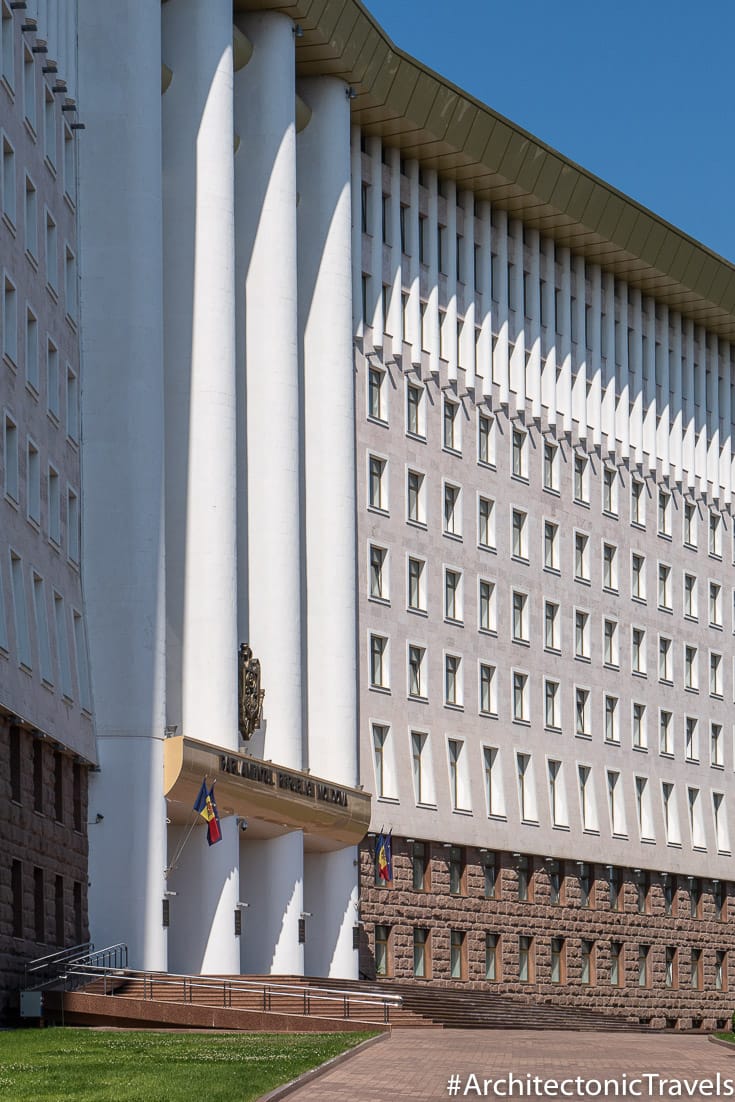
If you are in Chisinau in summer, as we were this time, you’ll already begin to notice by this point how difficult it is to photograph many of these oversized megastructures in the city because of the number of trees obstructing the view. It’s frustrating, to say the least, and my only suggestion if you are a keen photographer and want to get the best shots, would be to use a decent zoom lens and get as far back as possible. Chisinau is known for its green spaces and parks, which makes it a pleasant place to be but it’s a pain if you are on a mission to photograph Soviet-era architecture!

Back on the other side of the road, next up is the Ministry of Agriculture and Food Industry followed by Publishing House and the glorious facade of the Fashion Centre (Casa de Moda). At this point, turn off Stefan cel Mare Boulevard and head towards the House of Writers. The building itself is nothing special but there is a nice mosaic, entitled “Winds-Waves”, on the side of it. You will also find some Soviet-era artwork around the back of Municipal Clinical Hospital for Children No. 1 and then if you continue to the front entrance of the nearby Dinamo Stadium there is some nice panel work on the top of the building. Walking straight down Serghei Lazo Street from this point, and then taking the last right before reaching Stefan cel Mare and Saint Boulevard once more will bring you to the impossible-to-photograph Government Garage.



Next is the Ginta Latina Centre for Culture and Arts, which was originally the House of Political Education during socialist times. From this point, head into Stefan cel Mare Central Park to see the now-abandoned Guguță Cafe and the nearby Stone Flower, which used to be a fountain but is no longer in use.
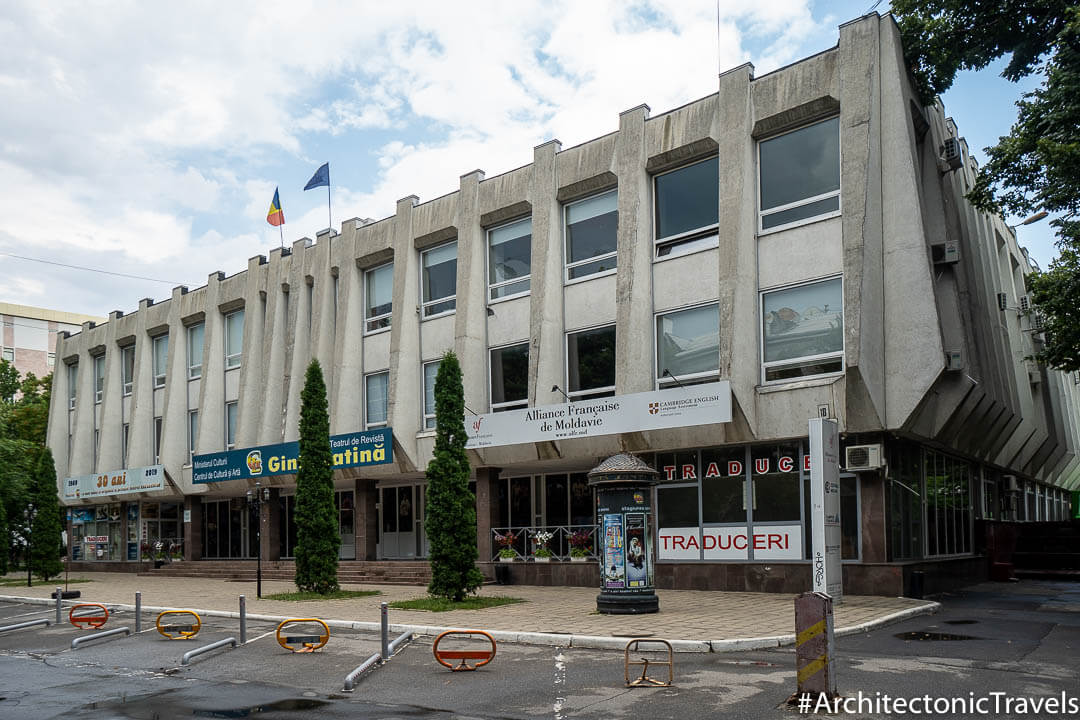

Heading back out of the park in a southwest direction will take you to the city’s former Friendship Hall, now the Palace of the Republic. Continuing along Bucuresti Street, you will notice the Chisinau Directorate for Culture, which was originally the city’s Palace of Youth. It has a pleasant cafe on the ground level should you require liquid refreshment. We then found a Soviet-style memorial near the Romanian Embassy, which I cannot identify as of yet and opposite that is the 1970s Gheorghe Asachi Theoretical High School, which used to be known as No.1 Secondary School.
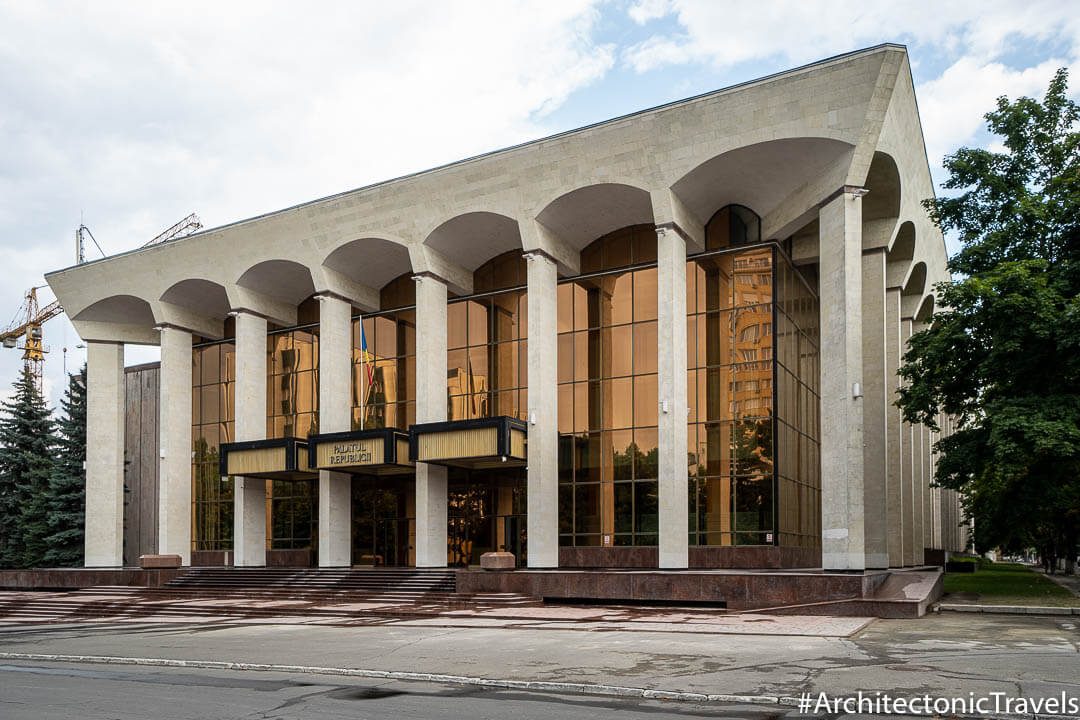
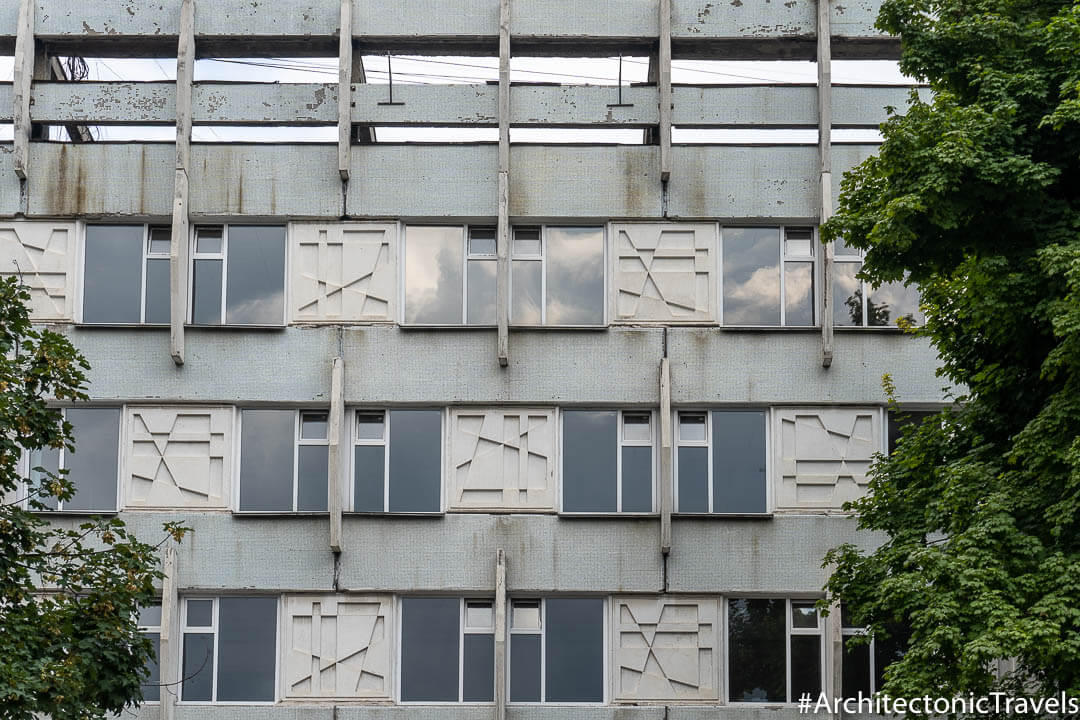
These days, it is difficult to make out what used to be the House of Press but the nearby National Palace Nicolae Sulac Concert Hall is still an impressive-looking structure. On the opposite side of the Chisinau Directorate for Culture, and part of the same complex, is the Licurici Theatre, and the final place of interest that we found in this vicinity is the Moldindconbank Central Branch building, which is four blocks southeast of everything else mentioned in this section.
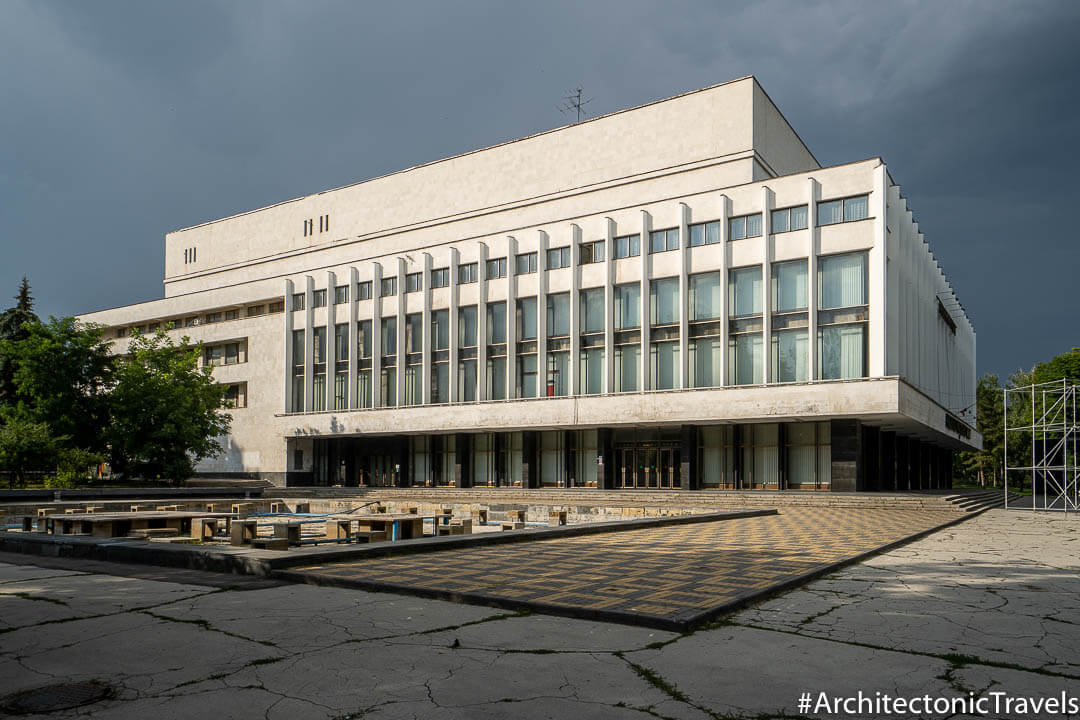

Heading east and then south of the bank, there is another smattering of interesting buildings, as well as some monuments and mosaics, that are worth discovering. The first of these is a small mosaic depicting a transport scene. It is sunk into the wall somewhat and easily missed even though it is in plain sight so you need to keep an eye out for it. The next big hitter, architecturally-speaking, is the Moldtelecom building which dominates the city’s skyline. Then head down to United Nations Square. While making your way there, look out on the righthand side of the road for the almost art deco-ish style wall-mounted sculptures located on the side of the Exhibition Hall of Artists Union named after Constantin Brancusi, the Romanian-born sculptor and painter who was considered a pioneer of modernism and known as the patriarch of modern sculpture.


On United Nations, formerly Liberation, Square itself you will find several buildings harking back to Communist times, including the derelict, and very modernist, National Hotel. The hotel was constructed in the late 1970s and, for more than a decade, was the city’s state-run Intourist Hotel, in other words, the best available. By all accounts, the attached restaurant was amongst the most popular in town and the ground floor of the hotel was the location of the city’s state-run Beriozka store (*).
(*) Situated in a number of cities in the Russian Soviet Federative Socialist Republic (SFSR) during the Communist period, these shops sold goods for hard currency only. I knew of them as Dollar Shops and remember visiting one or two in China in the early 1990s. There, they were called Friendship Stores.
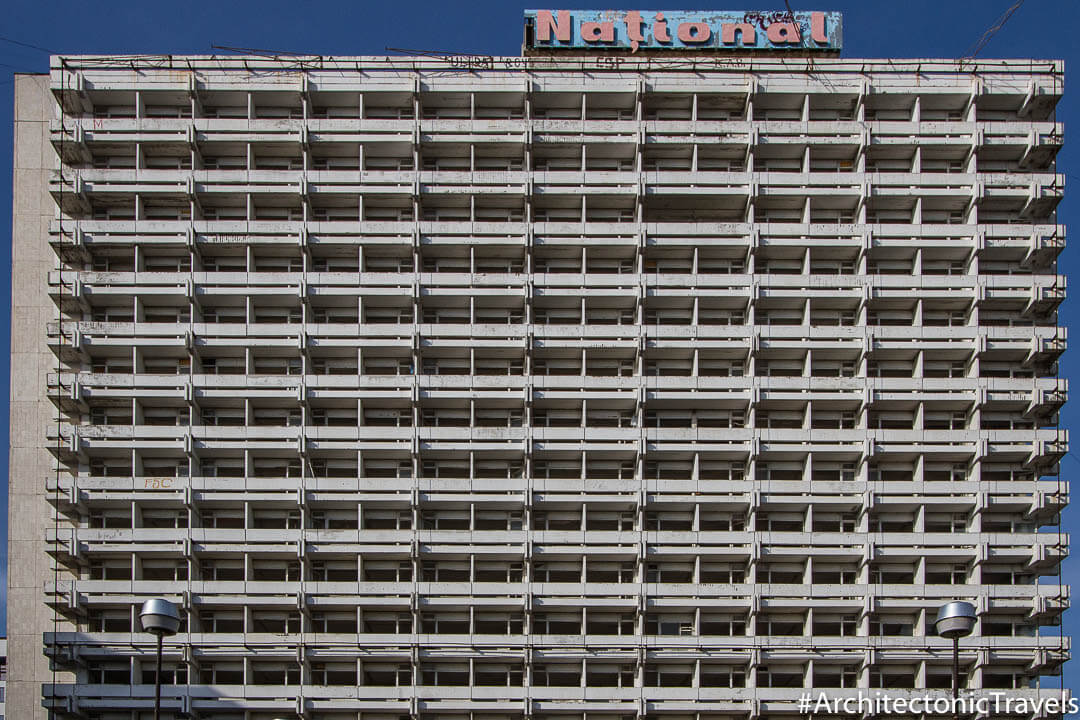
Also in the same location as the National Hotel is the former Moldova Tur Office as well as a selection of other buildings from the same era that are in a poor state of disrepair. Across the road, on Liberty Square, you will see the Monument to the Liberation, which has been nicknamed “Titanic” for obvious reasons. The inscription on the base of the monument reads “The monument was erected in honour of the liberation of Moldova from Nazi invaders.” Also on Liberty Square is the Chisinau Hotel (*). The latter is an example of Stalinist Empire-style architecture and I’m assuming the property was part of Alexey Shchusev’s original post-World War II blueprint for the city but I can’t find any evidence to back this up.
(*) Evidently, a hotel that has thought about its marketing strategy. The Chisinau Hotel encourages you to book with the superb strapline; ‘It’s like visiting your granny, not modern, but clean, warm and relaxing’!


Continuing along Stefan cel Mare Boulevard to the busy intersection at Constantin Negruzzi Square, you will come across the Hotel Cosmos, which is a fine example of one of those oversized, rather rundown Communist-era hotels that you still find all over the former Soviet Union. With plenty of retro touches, a decent location, reasonable lead-in prices and a strapline stating that “You will come as a guest and leave as a friend”, the Cosmos is an enticing option for anyone looking for authentic socialist-era lodgings.
Near the Hotel Cosmos, you won’t miss it, is one of the city’s finest examples of monumental art. Called “The Legend of Chisinau”, this particular mosaic takes up an entire end wall of the building it is situated on and was created in 1973 by Mikhail Burya, a Soviet-era artist who was responsible for a number of mosaics in both Moldova and, what is now, Transnistria.
Update; The five-storey building to which the mosaic was attached was demolished at some point in 2021. According to an online article on Locals.md, the mosaic was not destroyed in the process. Instead, the artwork was dismantled, and the intention is to re-erect it elsewhere in the city when a suitable home is found.
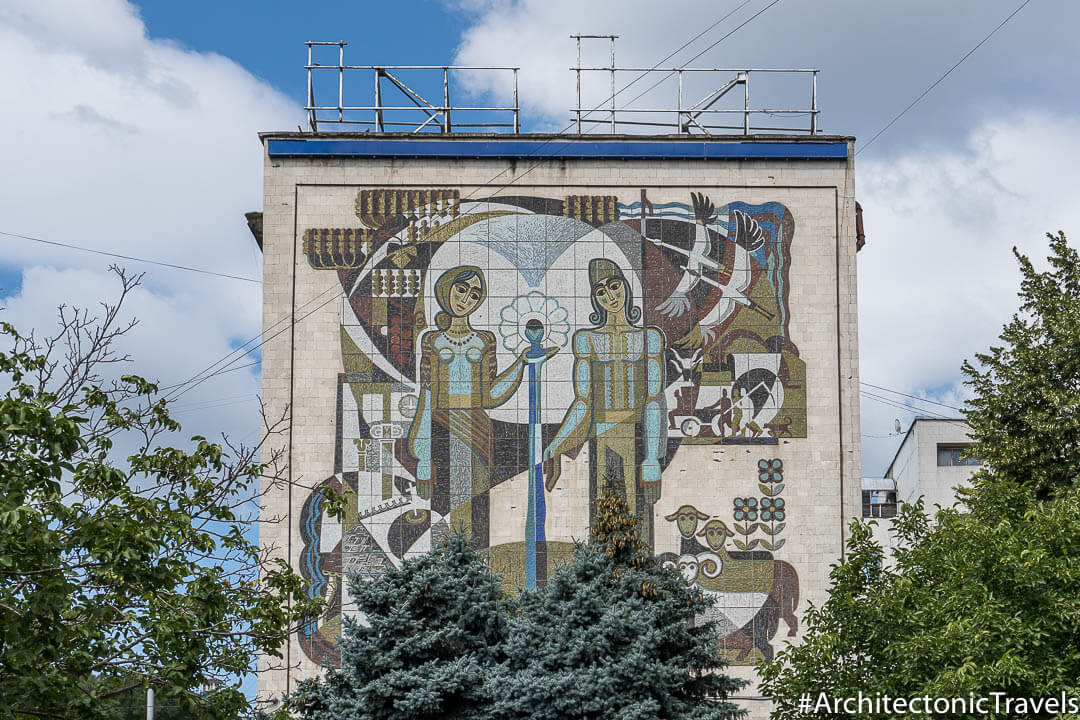

If you want to see a good example of the high-rise housing estates mentioned earlier, head north of the Hotel Cosmos towards Mazarache Church. Near the church is, what must surely be, one of the largest estates in Chisinau. It’s a worthy detour, as is Mazarache Church itself, which is considered to be the oldest in the city. From this point walk to the Central Bus Station, which is engulfed by the ever-busy Central Market. Inside the waiting room of the station is a wonderfully-detailed mosaic entitled “The City is Flourishing and Being Built”. Clearly, the bus station has been renovated in recent years but the mosaic has been left in situ, which is good to see, given that so many mosaics from the era are disappearing fast these days.

Soviet-era relics away from the centre of Chisinau
That’s it for our suggested Soviet-era walking tour of Chisinau but there is still plenty more to see and, arguably, much of it is more impressive than the stuff that can be seen in the centre.
Romanita Collective Housing Tower and the surrounding area
Once the tallest building in Chisinau, Romanita, informally known as “Daisy” (*), was built as social housing in the late ‘70s and early ‘80s to accommodate small family units. A socialist experiment in community living, the 73-metre high tower is still used for that purpose today but is showing definite signs of decay. For a great, distant view of the structure, head up to, or approach the building from, the ridge on nearby Tudor Strișcă Street.
(*) Romanita is the Romanian word for chamomile which is a form of daisy.

Reasonably close to Romanita Tower, the mosaic above the main entrance of the Alexei Stârcea School of Arts was one of the nicest we found in Chisinau. It’s a little bit tricky to get to on public transport as the bus doesn’t get you that close but it can be combined with Romanita if you are happy to walk a couple of kilometres between the two.
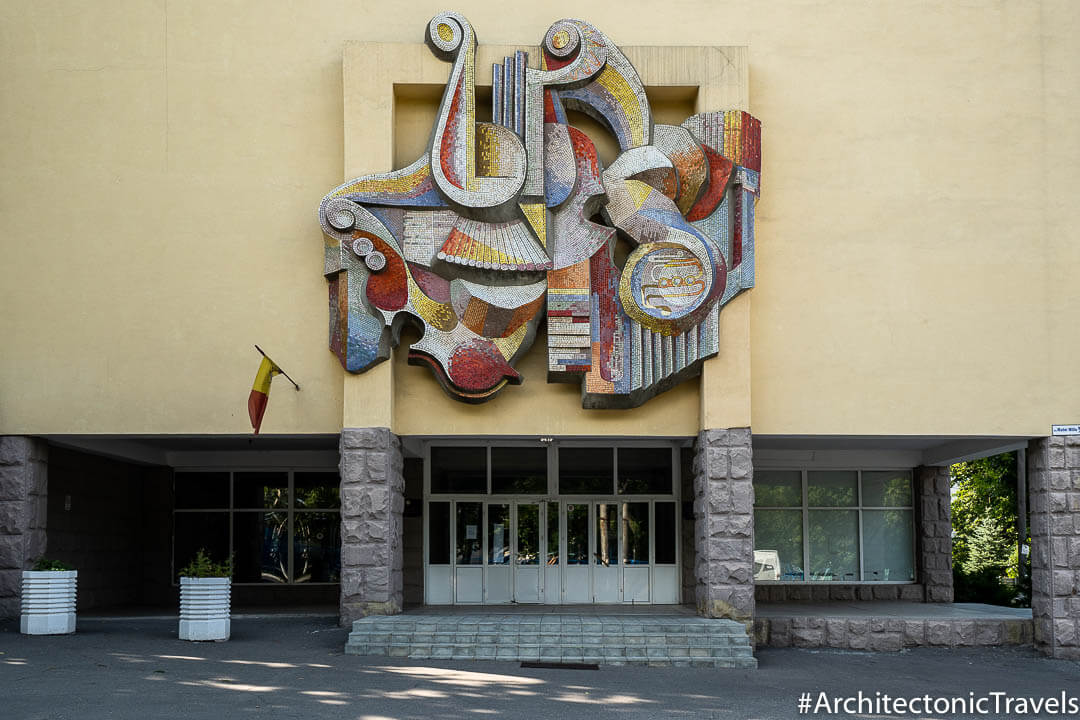
National Bank of Moldova and the surrounding area
Located northeast of Cathedral Park and reached via a short bus ride or a downhill walk, the National Bank of Moldova is a fine example of Post-War modernism architecture and, we think, one of the most interesting structures in the city. Opposite the bank is the building belonging to the State Tax Service/Fiscal authority of the Republic of Moldova. I cannot find any evidence to determine whether this structure was built during communist times or not but, to me, if definitely looks like it dates back to the 1970s or ‘80s and therefore is Soviet-era. The same goes for the Academy of Economic Studies of Moldova, which is just around the corner. If anyone has any definitive information about either location, please let me know.



Further down the same street, you will see the impressive Monument to the Heroes of the Leninist Komsomol (*) and directly to the left of it, the Hotel Turist. In their Eastern Europe guidebook, Lonely Planet suggests staying at the Hotel Turist ‘for a kitsch blast of Soviet past’ but I’d suggest opting for the Hotel Cosmos or the Chisinau Hotel if you want to go down that route. Personally, though, I’d stay in a €25 a night mini-apartment with all mod cons, which is exactly what we did last time around!
Incidentally, there is some interesting artwork on the end wall of the Hotel Turist entitled “Moldova”. You’ll find it above the hotel’s ground floor, now an Andy’s Pizza restaurant.
(*) Komsomol is the common name for the All-Union Leninist Young Communist League, the political youth organisation of the USSR.

Chisinau State Circus and the surrounding area
From the Hotel Turist, it is possible to head along Grigore Vieru Boulevard, cross the Bic River and walk up the hill to the marvellous Chisinau State Circus. In fact, if you want a distant view of the circus’s concrete-heavy top (you’ll need a decent zoom lens) then walking is the best option. Alternatively, plenty of buses head that way and stop right opposite the circus.
Officially opened in 1982, this once state-of-the-art circus building used to be the country’s premier entertainment venue and could accommodate nearly 2,000 spectators. There is an arena attached to the main circus building where performances are still held but the Soviet-era structure has long been in a state of abandonment and can only be viewed from the outside. Of all the circuses we have seen in the former USSR, and we’ve seen quite a few now, the one in Chisinau is probably one of the finest. Visit the circus in the morning if you want to photograph it in the best light.
2.5km east of the circus is a glorious mosaic attached to the main entrance of S.A. Termocom, Moldova’s original state-run thermal energy supplier/district heating service. It is entitled “Taming the Fire” and was created in the late 1980s. The detail in it is superb.
Also in the vicinity of the circus is the hulking building of S.A. Moldovagaz.



Eternity Memorial Complex and the surrounding area
The Eternity Memorial Complex, sometimes called the Victory Memorial, is situated in a manicured, peaceful and well-kept park that is an agreeable place to relax for 20 minutes or so. The flame is dedicated to Chisinau’s unknown soldiers who died during the Great Patriotic War (World War II). Time your visit with the top of the hour and you will witness the changing of the guard which involves plenty of synchronised goose-stepping.
350 metres west of the memorial complex is the majestic Monument to the Fighter for State Soviet Power, erected in 1966. Behind the monument is the Cinema ‘Gaudeamus’, which in itself would have been a building worthy of note in this post had it not been in the throes of demolition/renovation, we couldn’t tell which, at the time of our visit (July 2019).


Chisinau Railway Station and the surrounding area
Another building that was part of Alexey Shchusev’s initial reconstruction plan for the city is Chisinau Railway Station The original 19th-century structure was destroyed during World War II. The replacement building is worth admiring, both inside and out, but we were more interested in the mosaic to the right of the station entrance. Entitled “Hospitable Moldavia”, archive photos show that the actual creation has a lot more to it than can visibly be seen today. At some point after the artwork was completed, I cannot find out when, the cafe seen in our photo was erected in front of the mosaic and so, I’m assuming, given the cafe is prefab in construction, that the bottom half of the artwork is still intact and just hidden from view?


The Train of Pain – Memorial to Victims of Stalinist Repression, which is directly in front of the train station was completed in 2013 and therefore isn’t really applicable to this article but it is an interesting sculpture nonetheless and if you are visiting the station then it is worth stopping by to have a look at it. The Culture Palace of Railway Workers, on the other hand, and the ornate fountain in front of it were constructed in the 1980s and are most certainly Soviet period. This was the only place in Chisinau where we had a bit of a run-in with one of those busybody caretaker types that you come across in this part of the world every now and then.
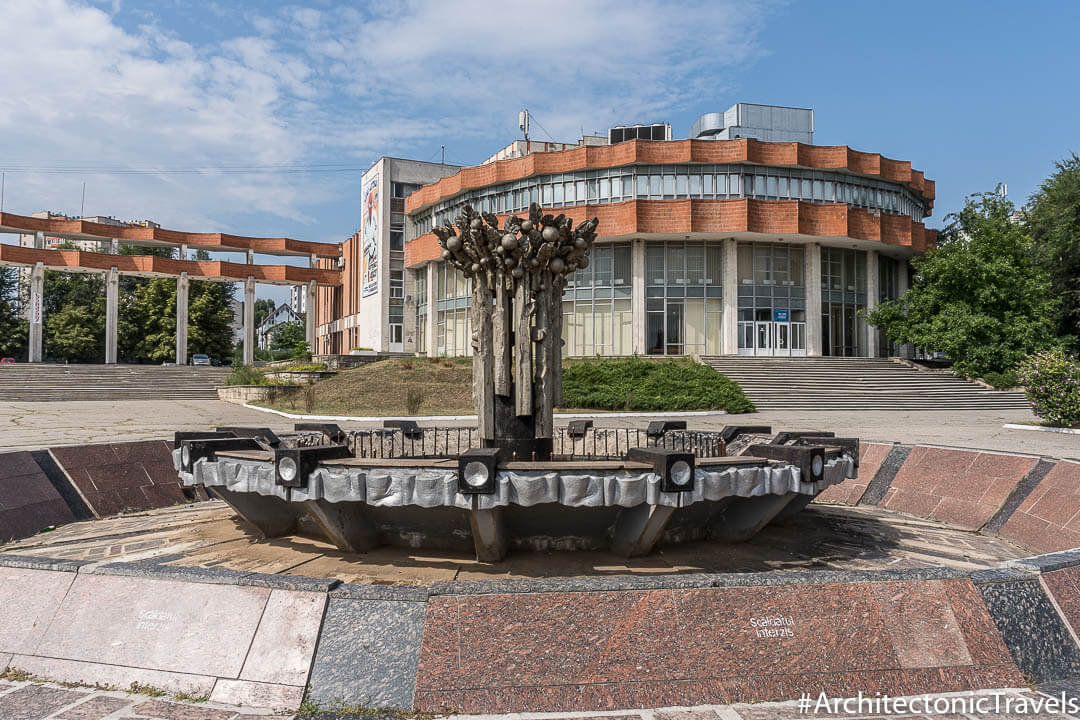
International Exhibition Centre MoldExpo
Located on the western edge of Valea Morilor Lake, this partly abandoned Expo Centre is not as interesting as the one we visited in Kyiv but if you want to see what is allegedly the last remaining public statue of Vladimir Lenin left in Chisinau, (*) then this is the place to visit. Once in a prominent position in front of Government House, Lenin, along with Karl Marx and Georgi Dimitrov (the first communist leader of Bulgaria), now stands in a rather unceremonious corner of the Expo known as the Wall of Honour.
(*) I’ll stand corrected if this information isn’t right. Let me know if you know otherwise.
While at the MoldExpo, it is worth checking out the bas relief on the side of the former Main Pavilion, which is right next to the Wall of Honour, as well as Pavilion Number 8 which is now abandoned but accessible.


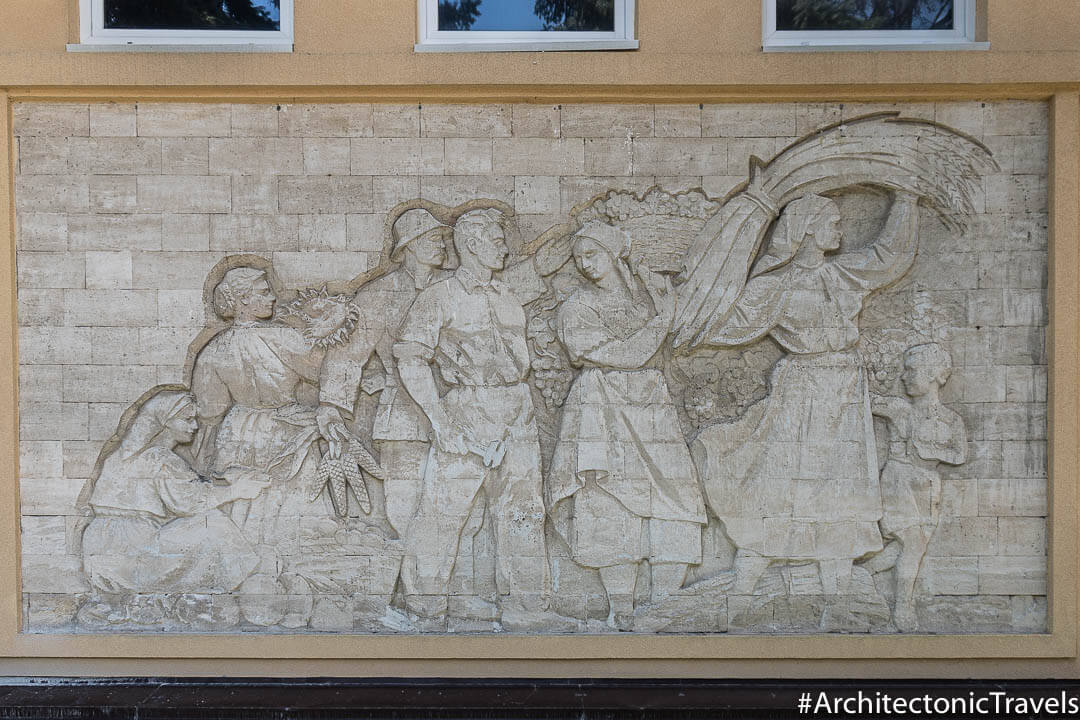
Moldova Film and the surrounding area
This is another good area to search for architecture and monuments associated with the Moldavian SSR. The Moldova Film building is best viewed from the other side of the underpass and in the grounds, and along one of the walls of the TeleRadio-Moldova building you will come across a couple of unusual pieces of art that were typical of public buildings throughout the USSR. Also part of TeleRadio-Moldova but a little further away is a faded but still distinguishable mosaic on the side of one of the company’s other structures.

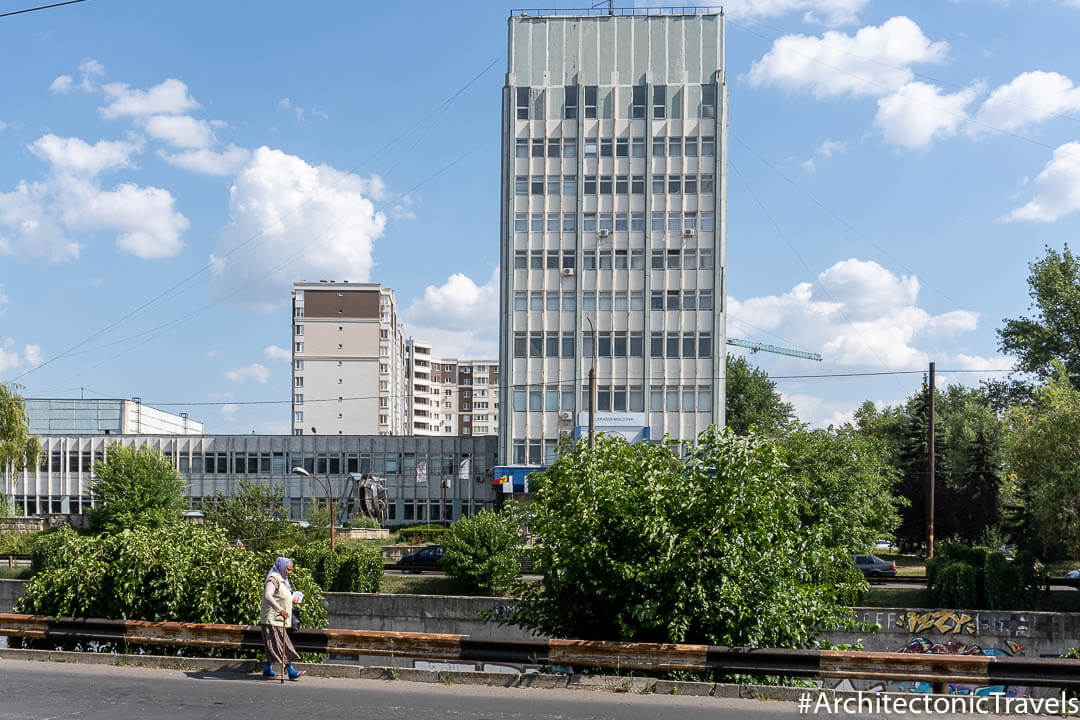
Serghei Lazo Park
Serghei Lazo Park is a triangular plot of land. At its northern tip, there is a Monument to Serghei Lazo himself, the Communist leader who took part in the October 1917 Revolution, while to the south of the park there is a large mosaic depicting a strong arm holding a Red Star on the side of an apartment building. Apparently, the text “Lenin’s Teaching is immortal, because it is true!” used to also adorn the same wall but it isn’t there anymore. Finally in this area, there is a small, Soviet-era placard on the ground floor of the same apartment building that is reminding the residents to keep the area clean and tidy.


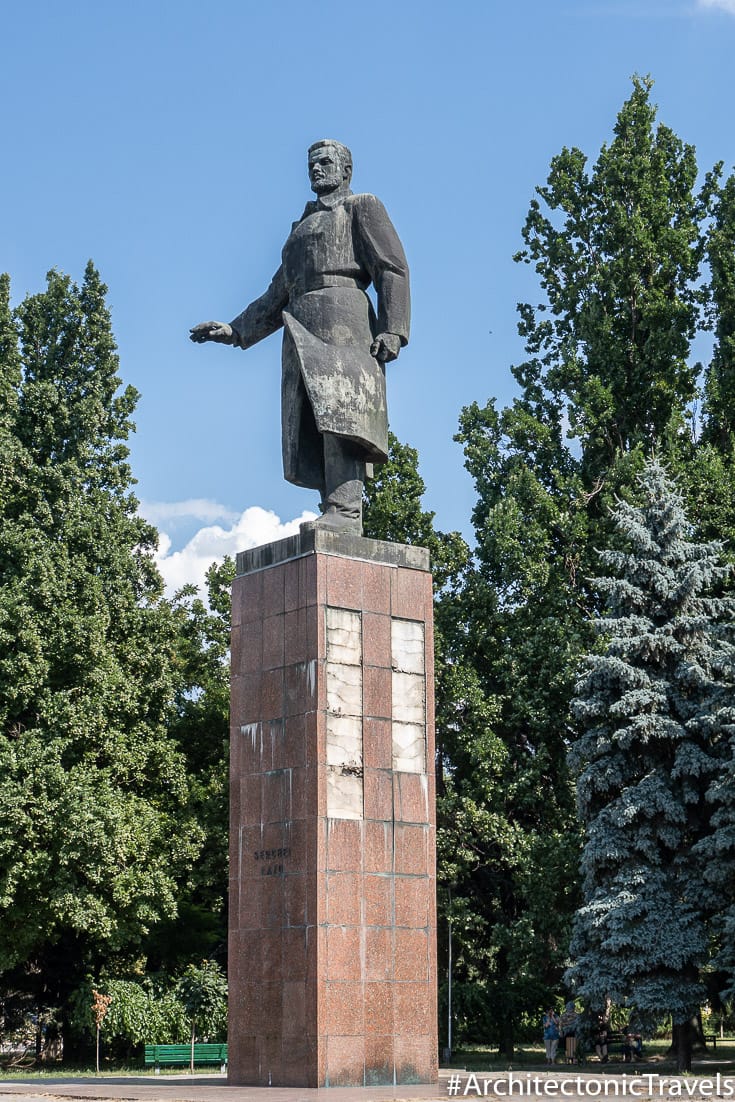
Technical University of Moldova and the surrounding area
There are three identical auditoriums in the grounds of the Technical University of Moldova. Each one used to be fronted with monumental art dating back to the mid-1970s. At first glance, it looks like the art is still in situ but, in fact, the artwork on the facades of the three buildings is relatively new (circa October 2018) and has been created over the top of the original designs using a form of decoration known as sgraffito, as this article confirms. It’s a pity to have missed seeing the earlier versions of whatever was on the walls but the three new compositions are still worth viewing and reaching the university on the bus is pretty easy to do as the campus is located at the end of the line.
Whilst in the area, there is an apartment building about 1.5km south of the university that stands out because of its unusual external decoration. Located in the Ryshkanovka district of the city, the nine-storey building, with the inscription “Tashkent” on the side of it, was a gift from the Uzbek SSR after the area was affected by the 1977 Vrancea earthquake, a 7.2 magnitude tremor that was felt throughout much of the Balkans and destroyed or damaged more than 20,000 structures in the Moldavian SSR. “Tashkent” was erected by a team of designers and builders who came from Uzbekistan, as did the materials, and the building was a return gift as the Moldavian SSR had done a similar thing for the Uzbeks after they experienced a catastrophic earthquake in 1966 which almost destroyed the city of Tashkent.
If you’ve been doing your own research, you might have seen photos of the impressive mosaic on the side of the former Palace of Culture of Trade Unions, which is also located in Ryshkanovka district and not very far from the “Tashkent” apartment building. Unfortunately, the entire building, including the mosaic, has been knocked down so don’t expend any effort looking for it.


Lake 1 and the surrounding area
There is an excellent example of modernist architecture on the northwest edge of Lake 1 in the shape of a former Sports Complex. It is completely abandoned but securely locked up so admiring the exterior is the only option here. It is possible, on the other hand, to get inside the derelict I.A. Gagarin Youth Centre, which is not that far from the lake. The main reason to come here is to see what’s left of the imposing “Plowman of the Universe”/“Glory to the Plowman” mosaic but, even though we’re not averse to exploring abandoned locations, I wouldn’t recommend entering this one. For starters, the fate of the centre (and the mosaic) is unknown but a large apartment building is being erected almost on top of it and part of the centre’s grounds are used as a car park/thoroughfare for the contractors working on the site so the chances of being spotted inside are high. Furthermore, and more off-putting, is the fact that a pack of dogs has made the place their home. Getting into trouble with a group of workmen is one thing but having to tackle a bunch of gnarly dogs is something else, and best avoided.
As for the I.A. Gagarin Youth Centre itself, it once boasted an 800-seater hall, sports facilities, a disco, and a hotel in which only foreign guests were allowed to stay. It was built using money raised at weekends by members of the Komsomol. A number of workshops were held at the centre, including one in which reportedly the first energy-saving lamp in the USSR was invented. Like so many buildings of its time, its demise is linked to the collapse of the Soviet Union in the early 1990s.
Opposite the youth centre is part of Chisinau Polytechnic College and you will find some rather nice bas relief on a couple of the exterior walls.


Former Cable Car Station and surrounding area
Northwest of the city centre, beyond Stefan cel Mare Boulevard, there is a former Cable Car Station that is only really worth looking for if you are hardcore about seeing as many Soviet-era relics as possible in the city. But, if you are up this way then it is definitely worth going to see the immaculate “Peace, Science, Labor, Creativity, Art” mosaic that used to be attached to the Palace of Culture of the Iskozh Plant but is now a Mazda showroom.


Chisinau City Gates
Like in Belgrade and some other former socialist cities, two large residential buildings were constructed in Chisinau in the late 1970s en route from the airport to the city centre as symbolic City Gates. To fully appreciate the perspective, you need to travel a kilometre or so out of the city and cross the busy highway to the grassy verge in the middle of it and look back. As you can see from our photo, we couldn’t be bothered to do that. It was about 7pm and after a full day of exploration we were totally knackered and, for once, socialist architecture lost out in favour of a cold beer and a bit of sitting on arse time. I’ll get the proper shot next time we visit the city and update the post then but, in the meantime, you’ll have to make do with just one side of the gates. If you continue along the road back towards the city, you will see several other towering apartment blocks that are worth a peruse if you are in the area.

There you have it, a week’s worth of solid exploration in a city that is well worth spending a week in. If you find anything else please let us know as we intend to revisit Chisinau in the not-so-distant future and would welcome any suggestions you might have.
READ MORE BLOG POSTS FEATURING POST-SOVIET STATES
Are you a fan of Soviet-era buildings and monuments? Pin this guide for your next trip!





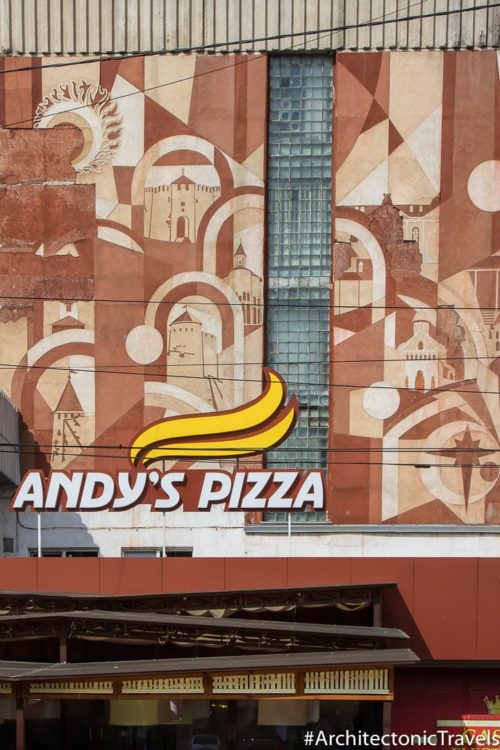

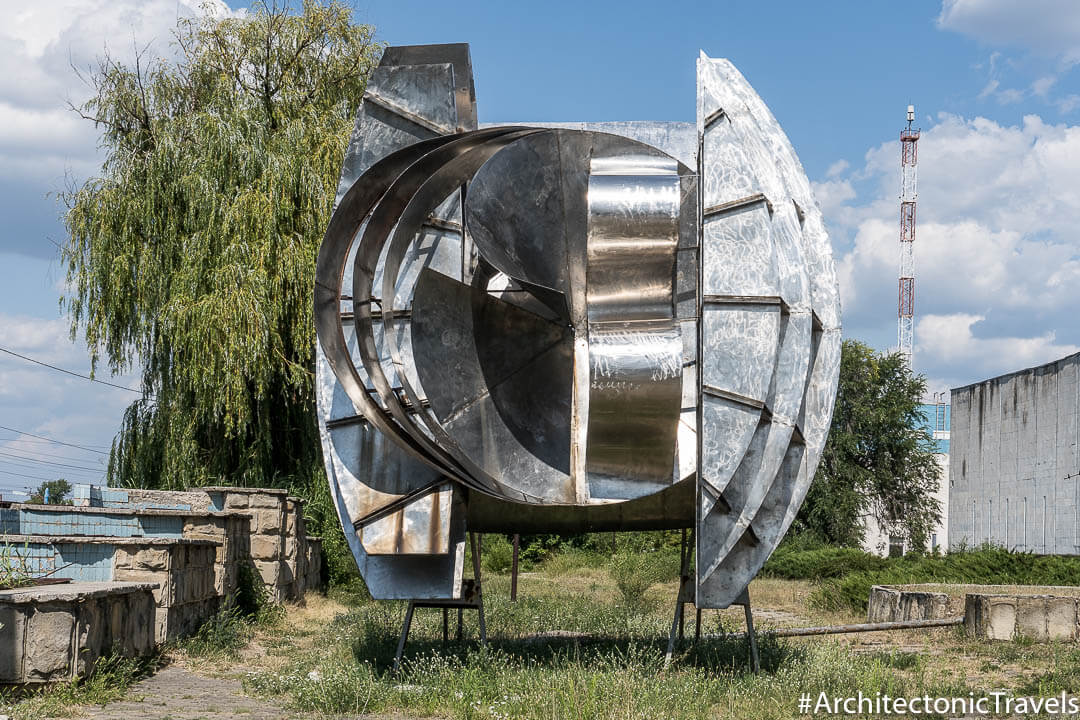
Ha, you crack me up with the hotel slogans.
Chisinau. hmmm. Well, not a place I would rush to based on this. I know you love that kind of architecture…reminds me of Skopje and Mostar kind of blended together.
Always enjoy your posts though, you have a way of encapsulating a place on your posts and I feel I’m right there…without having to be there 🙂
Frank (bbqboy)
I reckon you are right Frank, if you aren’t into the style of architecture you probably won’t find much else of interest in Chisinau as a tourist. But don’t dismiss it completely, I think it would make a good base for a month or so. The people are great fun and the city is very good value for money. We had a small apartment right in the heart of the main market and really enjoyed the location – fresh food, stand up bars and a buzzy atmosphere plus Moldovans, particularly in Chisinau, speak pretty good English. We would go back but not to see its tourist attractions!
Really, you’d actually recommend it as a base for a month? I don’t know, just seems a bit isolated…
By the way, the place we ARE thinking of staying for a month in the spring is Lviv in the Ukraine. Your last post on the Ukraine inspired me, plus we want to see Poland and the Moravia region of the Czech Republic. Lviv is right there, plus is non-Schengen which makes it the perfect place to in the area (I had to find a month in between the Schengen zone countries).
Frank (bbqboy)
Between Chisinau and Lviv, I would definitely pick the latter. Chisinau is fine if you just want to settle in for a bit but, as you point out, Lviv is better located for seeing other places in the region. Lviv is a lovely place, you won’t go far wrong if you do choose it as a base.
Late to the party here, but I just had to chime in.
Oh wow, save the dripping disdain there, pal. Having just seen Sault St. Marie in 2022, y’all Canadians can sure build UGLY. Uglier than anything I have ever seen in Moldova, without the excuse of a colossally traumatic past including getting the shit bombed out of us during WW2, organized famine, and mass deportations in the 20th century alone. Maybe actually GO to Chisinau before poo-pooing it. Some serious west-splaining Dunning-Krueger syndrome here – opinions on everything you don’t know about.
Gorgeous! I’m in Bulgaria for the month, and I’m loving the communist-era architecture here too. Cheers!
Thank you and indeed, Bulgaria has so much! I’ve just finished a not yet posted article about communist-era architecture in Sofia but there is plenty more scattered throughout the country. If you haven’t already done so and you have the time, check out the Monument to 1300 Years of Bulgaria in Shumen, Buzludzha Monument in Shipka and the Park-Monument of the Bulgarian-Soviet Friendship in Varna to name but a few. I would be happy to send you a list of what else we saw in Bulgaria if you are interested?
Spent a couple of dayes here last year. Was curious to see your take on the city. Sorry I missed the Romanita building. Enjoyed visiting the Victory Memorial. And…I stayed in the Chisinau Hotel, described perfectly!
Lucky you, staying at the Chisinau Hotel. We opt for apartments when we can but we should have had at least one night in the Chisinau Hotel or the Cosmos! The Romanita building is marked on the map above if you ever go back – it was a bit of a pain to find at the time and we had nearly every passenger on the marshrutka that took us there getting involved with directions at one point or another – friendly folk, the Moldovans!
Thanks for this post! We’ll be in Chisinau for a day before heading to Kharkiv next year, and modernist architecture will be the name of the game for us while there.
Lovely photos as well – can’t wait to read more about your time in the region!
No worries Nick, I think you will enjoy Chisinau and if you have a full day, you will see everything mentioned above and have time for a few beers 🙂
Great page, thank you, we are a group of 10 architects/historians and eager to see all this in April. Thanks again.
You’re welcome. I hope you enjoy what you see!!
Check your sources before you write, or at least don’t make general assumptions. Moldova wasn’t liberated by the red army in 1944 but perhaps occupied.
Thank you for your comment Radu. In August, 1944 the city was ‘freed’ from Axis forces by the Red Army but you make a good point and I accept that ‘liberated’ is a poor choice of word given the subsequent history. I’ve now change it.
It was liberated. No need for inverted commas. Whoever thinks otherwise is a revisionist/nationalist.
Like we were “liberated” in 1940 when the Soviets issued Romania an ultimatum to relinquish Moldova? Or do you perhaps mean 1812 when Western powers just “handed” Moldova to the Russians as a “reward” after kicking the shit out of Napoleon?
FYI, whoever thinks Moldova was “liberated” in 1944 obviously has not had family deported in the years after or subjected to famine or deportations, or having all their property taken during collectivization, or their names butchered into the Cyrillic alphabet. But hey, Russian imperialism is obviously make-believe. *SARCASM*
So, which one are you, a Russian irredentist, a member of the 5th column, or just in Putin’s pocket? Or are you just a hypocrite who votes for pro-Putin elements all while carrying a Romanian passport so you can go shopping in Europe because your ancestors were born in “Greater Romania”?
Some of the monuments are amazing but really hate those electric wires
I agree, electric wires are a real pain when it comes to photographing highrise architecture!
Great blog. I live and work in Chisinau as an ex pat Brit and you have given me a great walking tour as a history teacher. Chisinau and Moldova really grows on you and it is not like anywhere else I have experienced, including a spell in Siberia. Outside of Chisinau, the Soviet era monuments, bus stops, town halls, murals, are still there. They are now part of the modern Moldova and there is so much to see here. People are wonderful when they open up. Thank you for not leading with the typical hackneyed cliches of poverty, corruption and wine.
Thanks for the compliment Rob, we appreciate it! I agree with your statement that both Chisinau and Moldova grow on you. We liked it the first time went there a few years back and even more so this time around. It is interesting what you say about Soviet relics away from Chisinau and how they are now part of modern-day Moldova. I’ve also written a post about Comrat, which hasn’t been published yet but, in it, I mention all of the monuments etc. you see from the window of public transport and how having your own wheels in Moldova would be great because you can stop and see them all along the way. I think that is going to be our next trip!
P.S. We like drinking wine, but touring wineries bore us stupid!!!
I have been to Chisinau 6 times or more ,I find it a great place to stay usually for 10 days at a time in different parts of the city ,luckily my lady friend is Moldovan and is a big help with the language etc .We usually rent an appartment for our time there as she lives in Hinchesti but that is a town on the list to see as well.Moldova is like Marmite some people think it is awful and others see a different side .I love the people making music outdoors on a summer Evening and i have heard some really talented playing and singing .Beer is cheap ,food is nice whats not to like.
Hey Alan, what’s not to like? Exactly, we also think Moldova is a wonderful country. It is highly underrated, inexpensive and, as you say, the people are welcoming and fun to be around. I know this post is about Soviet architecture and monuments but, we have discovered other aspects of the country on our travels such as the marvellous countryside and monasteries. Hinchesti is on our list for the next time we visit. Thank you for your positive comments about Moldova!